Check out this SlideShare Presentation:
Search This Blog
Wednesday, April 20, 2011
Tuesday, April 19, 2011
Marketing in Indonesia – Market Overview and Review of Best Practice
Marketing in Indonesia – Market Overview and Review of Best Practice
It's not so long ago that Indonesia was known as widely for its currency crisis and vulnerability to natural disaster as for its fine beaches and nasi goreng. In the past decade, however, democracy, growing wealth and economic stability in spite of global chaos has transformed this Southeast Asian archipelago from a country on the brink of collapse to a powerhouse of growth and consumer demand.
The fastest-growing market in the ASEAN group of countries, Indonesia was identified in 2005 as being among the 'Next 11' world markets – those after the BRIC giants that had the most promising outlook for investment and future growth. This is a market fuelled as much by domestic demand as by exports, meaning that, along with India and China, it's less susceptible to damage by sudden shifts in international demand. Indonesia has the world's fourth largest population—nearly 240 million people – and its economy grew a healthy 6% in 2010, according to the IMF. Growth in Q1 of 2011 was expected by the Indonesian Central Bank to reach 6.4%, as exports rise and demand at home intensifies, and some forecasts expect it to be one of the biggest five economies in the world by 2030.
This is a young market; vast numbers of Indonesians have not known war or recession. Having grown up with increasing prosperity, they have no reason to expect anything less in the future. When they have money, they tend to spend it, with saving being a fairly low priority. Euromonitor analysts describe Indonesia as "bursting with vitality and among Asia's most dynamic countries". Over 37% of the population is aged 15 to 29 – nearly 85 million young people who are avid consumers and are hugely excited by new technology. This remains, however, a country of huge contrast; Twitter is used by about 20% of the population, believed to be one of the highest penetration rates in the world, yet only 29% of households nationwide have a refrigerator. As prosperity grows, however, so the ranks of the middle class swell.
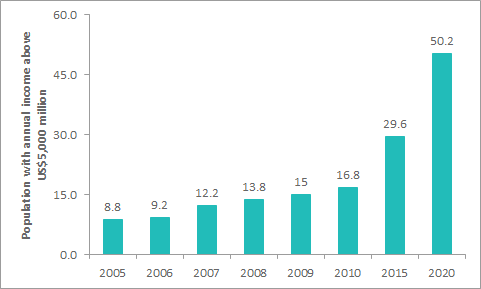
Source: Euromonitor
Synovate's PAX survey, which monitors the acquisitions and attitudes of Asia's wealthiest 20% of society based on monthly income, shows that, as of November 2010, 62.9% of affluent consumers in Jakarta own a car, but 27.1% planned to buy one in the coming 12 months, the second-highest in the region behind only Bangkok residents (28.6%).
BRAND AMBITIONS
The opportunity here for multinationals and for strong local brands is clear, and investment in goods production and marketing is unsurprisingly strong. While 'growing up' toddler milk is the biggest mover in the drinks category here, as parents look to give their children the best possible start, soft drinks too are big business. Local producer PT Sinar Sosro and international PT Coca-Cola Amatil Indonesia are both targeting sales growth of 10-12% this year, and are increasing production capacity to meet anticipated demand.Coca-Cola Amatil, the Australian-based bottler and distributor for Coca Cola across the Pacific region, is investing around US$100 million in Indonesia over three years, doubling the company's investment in the country, with plans to expand into new products and categories. At the same time, L'Oréal Group, the world's largest cosmetics and beauty company, is building its largest factory in the world in Indonesia, investing US$100 million this year, half of that in the new facility. It is aiming for 30% growth in annual sales in the country, and is hoping to attract 50 million new customers in Indonesia by 2020.
As individuals get a little more money in their pockets, they start to consider spending money on new products. Unilever, for example, is hoping to encourage Indonesians to start treating themselves to ice-cream more often. While many Asian markets are among the world's biggest ice-cream buyers, consumption per capita is among the lowest in Indonesia, with the low penetration of fridges probably a factor; by far the majority of sales are impulse, single-serving buys rather than packs bought for consumption at home. Unilever hopes Indonesians will take to Wall's Cornettos, Paddle Pops and other frozen goodies, and has been investing heavily in marketing them in the past year. The company has also launched ice-cream counters in malls to boost sales, growing both market share and the overall size of the market.
For foreign brands with a more established hold on the market, strategies involve building on existing loyalties. LG, for instance, recently ran a cross-platform campaign to mark the electronics brand's 20th year in the country. In ads showing the role of LG products in enriching family life, the company thanked consumers for making them the number one electronics brand in the country, one that sells an LG product every six seconds there.
ADSPEND SURGE
As brands local and foreign seek to capture a greater slice of this growing market, investment in advertising is booming. Overall adspend in 2010 grew 23% to a total of Rp. 60 trillion (US$6.9 billion). That was the country's strongest adspend growth since 2006, largely due to natural growth but also fuelled by additional spend around the World Cup finals in the summer, when Nielsen figures show spend in June and July was up 30%. In fact, the 10 most-viewed programmes all year were all football events, both World Cup and the AFF Suzuki Cup, where Indonesia's national team reached the finals. Per capita adspend remains low by world standards, however, with spend in Indonesia only a tenth of spend per capita in Australia, and less than half of that spent per capita in China.Telecommunications services and equipment brands are now the country's biggest investors in advertising, taking over from drinks brands and personal care items, and eclipsing spend by the cigarette industry, which just five years ago was in the top two categories for adspend. Indonesia is home to about 43 million smokers (about 57% of men and 5% of women), and the sector is highly lucrative. Spending by the industry on advertising was reined in last year, however, when legal restrictions on advertising, which until then had been loose by international standards, became more extensive.
| Top 10 Categories in All Media Category | Y2010 | Change |
|---|---|---|
| Telecommunication | 5,550 | 43% |
| Politics | 2,984 | -18% |
| Corporate Ads & Social Services | 2,380 | 23% |
| Clove Cigarettes | 1,984 | 14% |
| Motorcycles | 1,889 | 19% |
| Finance | 1,859 | 46% |
| Hair Care Products | 1,837 | 20% |
| Facial Care Products | 1,568 | 32% |
| Snacks | 1,384 | 31% |
| Media & Production House | 1,320 | 12% |
| Top 10 Spenders in All Media Product | Y2010 | Change |
|---|---|---|
| Excelcomindo XL | 593 | 66% |
| Telkomsel – All SIM Card | 538 | 79% |
| Telkomsel Simpati | 438 | 198% |
| Telkomsel Kartu AS | 398 | 125% |
| AXIS | 396 | 6% |
| Indosat M3 | 320 | 13% |
| Local Government Candidates | 309 | 673% |
| ESIA | 296 | 24% |
| Sedaap – Instant Noodle | 291 | 34% |
| AQUA – Mineral Water | 280 | -6% |
discount or promo, etc.), in Rp. Billion
THE DIGITAL OPPORTUNITY
Where these brands are choosing to advertise is a story that says a great deal about the way Indonesia is developing. GroupM's This Year Next Year report shows that TV remains the dominant advertising medium, taking 60.4% of total adspend, and with revenue growth in 2011 forecast to hit 25%.Newspapers take roughly a quarter of spend (growing at 15% this year), radio, magazines, outdoor and cinema each account for less than 3% of spend. But it's the spend going into online media that's really exciting. This year, it will only account for 8.1% of spend, but the money brands are injecting into it, and especially into social media, which accounts for about 80% of all online adspend, is expected to grow 200% this year.

Source: GroupM 'This Year Next Year'
| % shares of media | 1999 | 2000 | 2001 | 2002 | 2003 | 2004 | 2005 | 2006 | 2007 | 2008 | 2009 | 2010f | 2011f |
|---|---|---|---|---|---|---|---|---|---|---|---|---|---|
| TV | 63.7 | 64.0 | 61.7 | 62.9 | 65.2 | 64.8 | 68.8 | 68.7 | 65.9 | 63.3 | 60.5 | 61.4 | 60.4 |
| Radio | 3.4 | 3.3 | 3.4 | 3.1 | 2.9 | 2.4 | 2.1 | 2.1 | 2.1 | 1.9 | 1.8 | 1.5 | 1.2 |
| Newspapers | 22.6 | 23.7 | 25.1 | 25.0 | 23.7 | 23.5 | 20.6 | 20.6 | 23.6 | 26.1 | 28.4 | 27.0 | 24.4 |
| Magazines | 5.3 | 5.4 | 5.9 | 5.4 | 5.0 | 4.6 | 4.1 | 4.1 | 3.9 | 4.0 | 4.0 | 3.5 | 2.9 |
| Cinema | 0.1 | 0.1 | 0.1 | 0.1 | 0.1 | 0.1 | 0.0 | 0.0 | 0.0 | 0.0 | 0.0 | 0.0 | 0.0 |
| Outdoor | 4.9 | 3.5 | 2.1 | 1.7 | 1.6 | 3.0 | 2.8 | 2.8 | 2.9 | 2.8 | 3.2 | 3.1 | 2.9 |
| Internet | 0.0 | 0.0 | 1.8 | 1.7 | 1.7 | 1.6 | 1.5 | 1.6 | 1.8 | 1.9 | 2.1 | 3.4 | 8.1 |
| Media total | 100 | 100 | 100 | 100 | 100 | 100 | 100 | 100 | 100 | 100 | 100 | 100 | 100 |
"TV is the most loved medium here – Indonesians spend at least three hours a day watching TV for information and entertainment. With television, we can reach at least 70% of the Indonesian audience, and more cheaply than with other media," says Henny Minarti, head of Mindshare's Indonesia office. "What's also appealing is the availability of pre- and post-campaign measurement, so accountability is easy to track."
But with mobile phones and cheap subscription packages that include all-you-can-eat data options, the media landscape is being transformed. Online gaming becomes accessible for the vast numbers of people who don't have a computer at home, and social networking is a massive phenomenon at all age levels. Euromonitor ranks Indonesians as the second-biggest population group on Facebook, behind the United States but ahead of Britain, and the third-biggest on Twitter. The last quarter of 2010 saw more than five million users from Indonesia join Facebook. Data from Facebook and GreyReview show that in January 2011, there were 32,129,460 registered Indonesian Facebook users, compared to 26,598,240 in October 2010. Twitter is an especially good fit for Indonesians because while English is widely spoken, especially on Java, the most populous and technologically advanced island, the local language, Bahasa Indonesia, uses text-friendly Roman script.
Nanda Ivens, who runs Edelman's digital practice in Indonesia, says the pace of growth in social networking is "just crazy". Location-based social networking, through sites like Foursquare, is now starting to take off. Virtually all of it is done via mobile. Handsets are cheap – so-called 'stupid phones', those without smartphone functions, are available for the equivalent of about $23. Clones of BlackBerries, known as Chinaberries, offer similar functions to the real thing but for less than half the price. "My driver has three phones and my maid has two," Ivens says, pointing out that this is not just a teen and twenty-something consumer but also older users, with over-55s proving to be big social networkers. 'Reunion fever' gripped Jakarta in 2009 as people reached out to old friends through Facebook, and it was a rare evening that any restaurant didn't have at least a table or two of reunited school friends. About 80% of broadband users connect to the internet via mobile.
User-generated media is also thriving, says DD 'Lulut' Asmoro, President of JWT Indonesia. Despite the need for pricey hardware – digital cameras or video cameras – a recent campaign for local potato chip brand Chipato attracted a response far higher than anticipated. Consumers were invited to upload their interpretation of the brand's belief that life should never be flat. The US$100 daily prize for the best entries probably helped motivate contributors.
The Unilever men's personal care brand Axe ran a highly successful word-of-mouth online campaign to support the launch of a new variant in 2009, which began with the creation of an online video that created an urban legend about a secret place where men were entertained by beautiful women. The video drove people to a blog, where entries made it seem that this place, The Mansion, was real, but known only to a select few people. After four weeks, the blog let it be known that it was an Axe promotion. The campaign attracted more than 65,000 page views in three months, and had 9,580 participants.
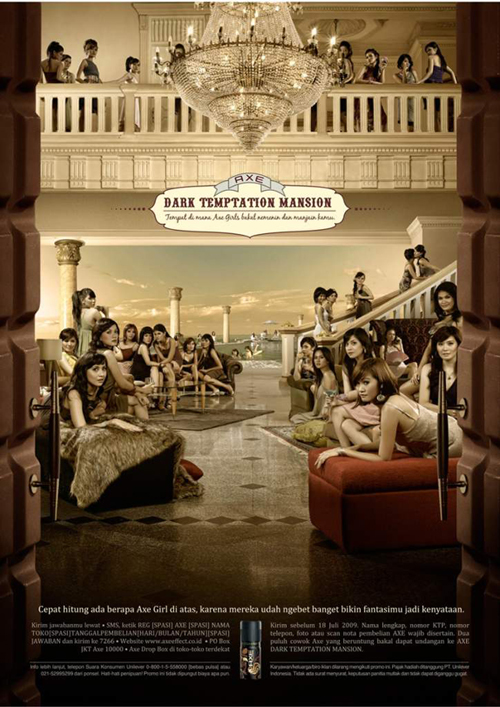
All this online advertising activity has begun to have an effect on more traditional media, says Minarti. "The sad side is that the client doesn't find extra money to spend on digital - the total remains the same, and digital spending is primarily taking from magazines and newspapers, and a little from TV or outdoor," he says. "It's made these media more flexible in the way they sell, however. They're more open to new, breakthrough executions, bundling cross-platform deals and giving special rates for long-term commitments and certain volumes."
The brands that are investing in new media are finding themselves among the most talked about online. Edelman and Brandtology's Digital Brand Index (DBI 10.3) tracks 53 of the largest technology brands across 467 online channels. Technology brands perform extremely well in the online talkability stakes, and of the ranking's top-10 'buzziest brands', nine have a local Twitter presence: Nokia, Telkomsel, Xl Axiata, Indosat, Samsung, Telkom, Intel, Bakrie Telecom and Sony. Some brands have several, specialist Twitter accounts for different purposes, such as customer service and information on specific products.
THE IMPORTANCE OF RURAL CONSUMERS
While there is wealth in this market, and increasing numbers of people with money to spend, there remain vast numbers of people on very low incomes, and rural consumers who live incredibly simple, Tweet-free lives. Electricity is not even available to every home in the nation.| Historic/forecast % penetration | 2009 | 2010 | 2011 | 2015 |
|---|---|---|---|---|
| Possession of Colour TV Set | 86.5 | 88 | 89.3 | 93.1 |
| Possession of Mobile Telephone | 44.7 | 49.4 | 53.4 | 64.5 |
| Possession of Personal Computer | 7.1 | 7.8 | 8.6 | 11.7 |
| Possession of Refrigerator | 27.7 | 28.7 | 29.7 | 33.2 |
| Historic/ Forecast - '000 | 2009 | 2010 |
|---|---|---|
| Passenger Cars in Use | 10605 | 11607.7 |
| New Registrations of Passenger Cars | 164.8 | 168.6 |
Brands that make an effort to deliver products and communications that speak to the rural consumer have shown it can pay dividends. This is one of the few global markets where a local brand outsells Coca-Cola in the soft drinks category – tea brand Teh Botol Sosro commands a bigger market share than the US giant.
Understanding that the vast majority of smokers still smoke clove 'kretek' cigarettes rather than Western-style sticks, Marlboro launched a kretek of its own in 2007. McDonald's Indonesia has a chicken-and-rice dish on the menu in addition to standard burger fare, and Kraft has had a hit with its Biskuat biscuits, fortified with calcium and vitamins to provide affordable nutrition, and nutritional drink Milkuat, which sold in excess of 10 million bottles in its first three months. Affordable pack sizes, down-to-earth communications and appealing promotions are much of the key to success in the most rural areas.
MARKETING SUCCESS
This is a market that's yet to grow cynical and jaded about advertising. "Most of what you see is still pretty silly and cheesy," says one old Jakarta hand. "It's really quite an innocent market. Mobile operators can walk up to people in a mall and ask people for their phone numbers and email addresses, and plenty of people will give it to them," he says.Yet creative in Indonesia are starting to push new boundaries, and just last year the WPP agency Y&R Jakarta became the first Cannes Gold Lions winner from Indonesia, with its outdoor work for LG.
Synovate's PAX survey found that affluent Indonesians are less flashy than other wealthy Asians; less than half said they enjoyed it when others saw how successful they were, compared to the 55% average for the region.
Few brands take a strong position on social or political issues, though the few that do can have a big impact. A local cigarette brand at the end of the Suharto era ran a campaign with the tagline that, loosely translated, meant 'Stop the bullshit'. More recently and less controversially, local Unilever tea bag brand SariWangi injected fresh consumer interest into what was already a market-leader by urging women to rethink their relationship with their husbands and use tea as a means of sharing, rather than serving. "This campaign really captures the spirit of the times and brings to life what many women are feeling about their changing role in the world," says Renuka Jaypal, chairman of Ogilvy Indonesia. The 'Let's Talk' campaign used relationship columns in print, TV ads, roadshows and digital to position SariWangi as the product that gave voice to women's wish for greater dialogue and closeness with their husbands. Personal stories were submitted online and have been compiled into a book that serves as a kind of girlfriend-bonding tool. (Click here for full details of SariWangi Tea campaign.)
Ann Lee of DDB Indonesia Group says humour is used frequently, but it tends to be more slapstick than ironic. BNI, the local bank, got talked about online for its use of irony, simply because it's so seldom seen. Far more commonplace is the approach used in Indosat's TV commercial for its Mentari mobile phone brand. This used sitcom-style humour, complete with canned laughter, for its family-holiday-gone-wrong demonstration of how a mobile can help users out of a sticky situation.
Sport is also big business, and sport sells products. The football World Cup had huge viewership last year. Motorcyclist Valentino Rossi was in Indonesia in 2010 for a Yamaha promotion, and several English Premier League football clubs have websites tailored specifically for Indonesia.
CASE STUDY 1: BANGO SOY SAUCE
Agency: Lowe Indonesia
Bango is a local brand of sweet soy sauce known as kecap, an ingredient used widely in Indonesian cooking. The brand wanted to convince consumers that this was the best sauce to use to make authentic Indonesian dishes, and position itself as the food that unites not just families but the country, filling hungry stomachs and hearts too.
The brand initiated a cross-platform initiative around cooking, including a weekly TV cooking programme that as well as giving cooking tips and demonstrations, talked to hawkers about their secret techniques and discussed the heritage of well-known dishes. The campaign moved on to discovering the nation's favourite dish, focused primarily on mothers identifying their families' favourite meals. Voting could be conducted via Facebook, Twitter and SMS, as well as offline.
The campaign came to a crescendo with a branded food festival in three major cities, which attracted more than 500,000 visitors and had a significant effect on consumers' view of the brand as providing 'a great taste experience' compared to rival brands. The brand's market share is its highest ever.
CASE STUDY 2: BLACKBERRY AND FACEBOOK
Agency: Edelman Indonesia
BlackBerry saw explosive growth in Indonesia in 2009, partly fuelled by the popularity of its BlackBerry Messenger function. The brand's Facebook page has attracted a following of about 840,000 fans, making it one of the most popular brand pages in the country.
Nanda Ivens of Edelman explains that the page became a kind of hub for customers, where they could ask questions, link to videos on YouTube or pictures on Flickr. "Some marketers see Facebook as another place for them to push their ads out," Ivens says. With this campaign, which ran over a year-long period, the Indonesian attraction to be part of a community was served by the brand, which rewarded fans with not only a place to chat and be part of a common-interest group but also gave them access to content that wasn't available to a broader audience.
The first peek at the Playbook tablet device was available through the Facebook site, and short films were made about how BlackBerry was using its Messenger function – an association of breastfeeding mothers was one of the groups featured, as was a group of tattoo artists. "There were some amazing stories," Ivens says, some of which were picked up and featured on technology blogs.
CASE STUDY 3: POP MIE NOODLES
Agency: JWT
This noodle brand, part of the Indofoods group, wanted to position itself as the brand that captured the spirit of the youth generation. Celebrating the fact that young people see themselves as creators, collaborators, connectors and at times even celebrities, the brand created an online playground for them, where they could play, create and be famous.
TV and press ads directed people to the web site Popupyourlife.com. Once on the site, users could upload a picture of themselves or take one with a webcam and see themselves become the star of one of three 15-second Pop Mie video ads, then share the results with friends via Facebook and Twitter. The site attracted more than 10,000 daily visitors – despite the fact that participation relied on having access to a camera and also having good-bandwidth broadband.
JWT's Lulut Asmoro says the aim of the campaign was to build affinity with young consumers rather than boost short-term sales. "These are cool ads, and if people see them as cool ads, then hopefully they see Pop Mie as a cool brand."

ABOUT THE AUTHOR
Jo Bowman writes on marketing and research for specialist magazines in Europe and Asia, as well as on broader business issues and trends. She has worked in Australia, Hong Kong and Italy, and is now based in the UK.Email her at jo@rjbmedia.net
http://www.warc.com/Content/ContentViewer.aspx?ID=cd061e75-0ede-432b-9bb4-d12d31370e75&ID=cd061e75-0ede-432b-9bb4-d12d31370e75&MasterContentRef=cd061e75-0ede-432b-9bb4-d12d31370e75
Yum Brands targets Indonesia
Yum Brands targets Indonesia
The US multinational operates in the country through a tie-up with indigenous partner PT Fastfood Indonesia, and hopes to rapidly expand its activity going forward.
KFC first established a local franchise in 1979, and having recently opened a 400th Indonesian outlet, now leads the quick service category.
Pizza Hut, the premier player in the casual dining sector according to its parent, also boasts over 200 branches.
“By 2015, we expect to have more than 1,000 KFC and Pizza Hut restaurants in Indonesia,” Siddharth Varma, managing director of Yum Restaurants International Asia's franchise business unit, said in a statement.
“We believe we have a long runway for growth in this dynamic emerging market. We have only two restaurants per million people in a country where nearly 50% of the population lives in urban areas.”
The company argued Indonesia's sizeable, and largely youthful, 245m residents, alongside a burgeoning middle class, leave it well placed to drive up revenues.
Yum Brands currently has 37,000 restaurants in 110 nations, and is boosting its emphasis on several other Asian geographies, such as China and India.
Warc subscribers can read a range of new insights into Indonesia's consumers and trading climate in the recently-published paper, "Marketing in Indonesia – Market Overview and Review of Best Practice".
Data sourced from Yum Brands; additional content by Warc staff, 19 April 2011
http://www.warc.com/LatestNews/News/Yum_Brands_targets_Indonesia.news?ID=28171
Gender effects in advertising
Gender effects in advertising
add+impact group
Introduction: the (not so) blank slate Since Aristotle, people have believed that at birth our minds are empty, a virtual blank slate, which will develop through reason and experience. It followed that any so-called gender differences emerged after birth and derived from social and psychological conditioning (Aristotle 350bc; Pinker 2002).However, the accumulating evidence strongly indicates the contrary. Wechsler had some difficulty finding gender-neutral measures, and regarded the differences in scores between males and females as a ‘nuisance’ (Moir & Jessel 1991). In-utero hormonal flows result in brains that already have gender-related predispositions at birth (Baron-Cohen 2003a; Brizendine 2007). For such intrinsic differences to exist, adaptive selection of physiological differences must have been taking place in humans long before our species became big-brained, conscious and forward thinking. Such hard-wired differences result in intrinsically different male and female personalities, and ways of dealing with issues, general approach and reactions in life (Baron-Cohen 2003a).
Advertising effects models have typically employed a similar paradigm, treating target audiences as effectively having no mental brand history and hence no predispositions based on their existing feelings about, and experience of, the advertised brand. This meant that all responses to advertising were measured from a notional zero base (Ambler 1998). A brief personal reflection will demonstrate that this perception is inconsistent with one’s own reality and hence cannot be valid in general. Rather, the way we respond to ads is a function of what we know and how we feel at the time about ourselves, about the brand, its competitors and our perceived needs.
Another long-held marketing belief has been that if the audience simply becomes aware of the advertising, then it has done its primary job, even if the brand is unregistered. However, simply getting audience attention is insufficient. It is the capacity of the ad to engender enhancement of generally pre-existing brand feelings that predicts the level of increased purchase intent after advertising exposure (Cramphorn & Meyer 2009).
Brand feelings are outcomes of an aggregated synthesis of brand emotions and experience over time. Advertising seeks to change these feelings. Advertising is most effective when the target is engaged with the advertising and with the advertised brand. Emotional changes in brand feelings are the best predictor of increased purchase intent after advertising exposure. Ability to gain advertising attention and reinforce brand feeling leads to strengthened purchase intent.
The generalised advertising response (Gear) model process (Figure 1) demonstrates that, after initial exposure to the ad (Watchability), the next phase is an enhancement of existing Brand–Person Relationships (formed from prior brand experience), resulting in changed Purchase Intent as the outcome of the ad (Cramphorn & Meyer 2009). Based upon this conclusion, this paper looks at the gender differences in advertising response that correspond to Watchability (Attention) and Brand–Person Relationship (Brand Impact).
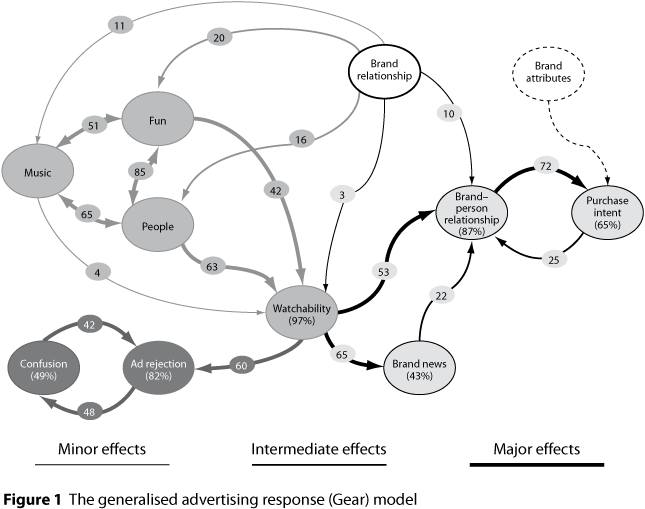
Females and males
At conception, two XX chromosomes lead to a female, while XY chromosomes result in a male (Moir & Jessel 1991). Gender effects commence shortly after conception and extend throughout pregnancy. However, the XY will develop, and eventually be born looking and behaving like a male, only if the foetus, around the eighth week after conception, generates sufficient male hormones (Moir & Jessel 1991; Brizendine 2007). Subsequent flows later in pregnancy further affect physiological differences including brain structure. At the same time that the body is changing, so is the brain. Gender-related testeronic hormonal flows in-utero result in brains that, at birth, are already physiologically and psychologically either female or male, with distinct predispositions specific to one or the other gender.
The hypothalamus controls sexual behaviour, and, depending on strength of hormone flow (primarily testosterone), the foetus will generally develop along a typical male or a female pattern. These hormonal flows also affect many other parts of the brain that collectively determine each person’s priorities, attitudes and feelings, and their responses (Rhoads 2004; Brizendine 2007). ‘The female brain is predominantly hard-wired for empathy. The male brain is predominantly hard-wired for understanding and building systems’ (Baron-Cohen 2003a).
For males, the rather small bridge linking the two lobes in the male brain makes cross-communication between the left and right hand lobes relatively difficult. This resulted, aeons ago, in male left and right lobes becoming specialised. If damage occurs to one side of the brain, males are likely to lose particular skills dominated by the damaged side. However, such differences are much smaller in females. The female corpus callosum is far broader than in males, with the two sides in communication. Therefore, if one lobe is damaged, there is less apparent subsequent mental or other impact (Moir & Jessel 1991). These predispositions have implications for everyday thinking and behaviour.
From the very first days after birth, boys look at faces but are equally fascinated by inanimate ‘things’; baby girls fix on faces (Moir & Jessel 1991; Baron-Cohen 2003b; Rhoads 2004; Brizendine 2007). Girls talk earlier, read earlier, and handle grammar better and earlier than do boys. Remedial reading and stuttering is far more common in boys. Girls learn other languages more easily and are more proficient in their own (Moir & Jessel 1991).
A well-known behavioural difference between men and women is the natural, innate aggression of men. Even as small boys, their rough-and-tumble is preparation for violent conflict; they use their bodies physically for dominance. Males are more likely to be derogatory or verbally aggressive as a way of achieving dominance, for status or, more subtly, occupational achievement. Boys are also more socially independent, while little girls socialise, and use social skills and diplomacy to get their way.
Females use words and are more subtle (Brizendine 2007). From early on, girls ‘play’ at parenting and ‘try on’ social roles. Females are far more socially orientated and skilled than males. They have intimate social arrangements, are concerned to maintain them, and have more empathy towards their friends. They maintain more eye contact, and smile and laugh more often. They can more readily read faces and feelings; they tune in to body language and they manage situations through diplomacy instead of showdowns. They are cohesive and mutually supporting (Moir & Jessel 1991; Brizendine 2007). Women ruminate about things that depress them, while men engage in distracting activities to take their focus elsewhere. Women share their problems and anxieties with other women, while men tend to internalise them.
There are gender-based differences relating to hearing, vision, pain, tactile sensation, taste and smell, in most of which women have greater sensitivity than do men (Moir & Jessel 1991). For example, girls’ noses, as well as their palates, are more sensitive, they are more attuned to sound – they hear better, they can sing in tune more easily, discern variations in sounds more readily, and women can hear baby sounds that are inaudible to men (Moir & Jessel 1991; Brizendine 2007).
Women see differently: they have more rods and cones in the back of the retina and are more sensitive to the infrared end of the spectrum. They see better in the dark and have better lateral vision, better depth perception and greater ability to match shapes. Women have better visual memory, remembering landmarks and positions of objects. However, men cope better with bright light and, because they see more narrowly, are better able to focus in on an object.
Women are better able to develop memory for names and faces, and have greater sensitivity to others’ preferences. Women also have better memory for verbal material (Croft et al. 2007; York n.d.). They spell better, and are better at mathematical calculation. They are more dexterous.
Where males succeed, it is partly due to their greater ability to focus and systematise. This means that they are more adept at analysing patterns and systems. They know where they are and can predict where others will be. They have a better-developed ‘intuitional’ sense of direction. They are better at reading maps, while women are better at reading character.
Males can more easily manipulate three-dimensional objects, both physically and conceptually (Moir & Jessel 1991). Men are better at solving mathematical problems requiring abstract reasoning. They have a better sense of perspective and have better spatial skills.
In general, males are poor at things that females do well – they are poor at empathising and may have no such capacity. For example, autism is rare in females (Baron-Cohen 2003a, 2003b). Suffice to conclude that very early pre-natal gender development determines our interests, abilities and the sorts of people we are.
Engaging with advertising
Probably not all of the differences between males and females listed above will prove to be relevant to communication but, knowing them, we can start to hypothesise about how differently men and women might respond to advertising.
Males respond better to ads about self, while females are more externally focused (Brunel & Nelson 2003). This is in accord with the male self-reliance and female sociability noted earlier. An exhaustive review of the research findings published on gender concluded that females process advertising elaborately over multiple exposures, while males see it once and have ‘got it’ (and are unlikely to reprocess it, even if they are wrong) (Wolin 2003). However, Wolin also describes the difficulty of drawing substantive conclusions when the literature is full of inconclusive and often contradictory findings based on small or convenience samples. Croft et al. (2007) identify differences in how men and women communicate, noting its potential usefulness for marketing. Evans, Nairn et al. (2000) summarise and confirm the impact of brain–gender differences. In their review, they confirm that there is evidence that men short-cut to conclusions while women first attempt to assimilate all the information. In reporting a study of gender effects in direct mail they found that women respond well when they can empathise, that photographs are more effective with women, while men respond to bold messages.
Cunningham and Roberts (2007) found that advertisers do not address women, and list areas of opportunity. The advent of social networking systems such as Facebook may lead to more gender-tailored ads based on user profiles (Hoy & Milne 2010). However, a recent finding that men and women are similar in their online cognitive needs should give pause to any temptation to generalise too readily. Still, it is noteworthy that the authors mention a greater emotional involvement by women in online shopping (McMahon et al. 2009).
Data
The add+impact® archive is a large and detailed worldwide record of consumers’ responses to advertising over two decades. As a resource, it overcomes the problem of small samples, and its diversity enables study of systematic responses to different styles of advertising, different product categories and international differences. Hundreds of thousands of individual results from thousands of advertising pre-tests enable comparison of the relative levels of engagement of males and females.
In the research process, the ad is exposed individually to the respondent without any clutter. Thus, people respond to the ad itself, and are not distracted or sidetracked by other advertising material or other people’s presence or comments. This is of particular benefit for this study as results are ad-specific, which eliminates any possible contamination of results. Following exposure, each respondent completes a questionnaire relating specifically to the test ad. These measures are very extensive, and thoroughly explore how people feel about the ad and its execution, and about the brand.
At the time of the analysis, a subset of the archive was selected. This contained the detailed responses for 3,045 ads. These represent all those ads where there is a specific record of whether the individual respondents are male or female. The results obtained from these ads form the basis for this study. Information was gathered for over 50 statements; however, for this paper, only two factors, each relying on six statements, were included. For the reasons noted earlier in discussing the Gear model, the two factors chosen are response to the ad creative (Attention) and emotive feeling towards the brand (Brand Impact).
Results
Targeting by gender
Ads were post-classified into three classes: ads that were tested with either just males, just females, or those tested with both men and women (broad-brush). It seems reasonable to surmise that advertisers know the brands’ target markets, and that this latter class – ads tested with both males and females – had the intent to appeal to both genders (since increasing sample size to include both genders would have the undesirable effect of increasing study costs).
Some items are intended primarily for use by one or the other gender and, for such items, brand advertising was tested with just that gender (cleaners and baby food were historically of little interest to males). In fact, such single-minded targeting is rare. Table 1 shows that both males and females were tested for 83% of all ads tested. The sheer size of this proportion may either simply reflect a lack of consideration, insurance that neither gender is alienated, a desire to have a bit each way, or even reflect the ‘saving’ in making one ad, not two. However, Figure 2 suggests that advertisers do indeed advertise to their audiences so probably none of these alternatives applies.
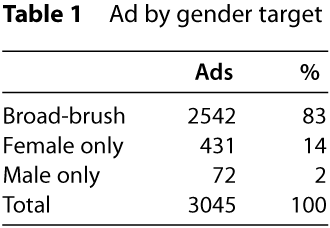
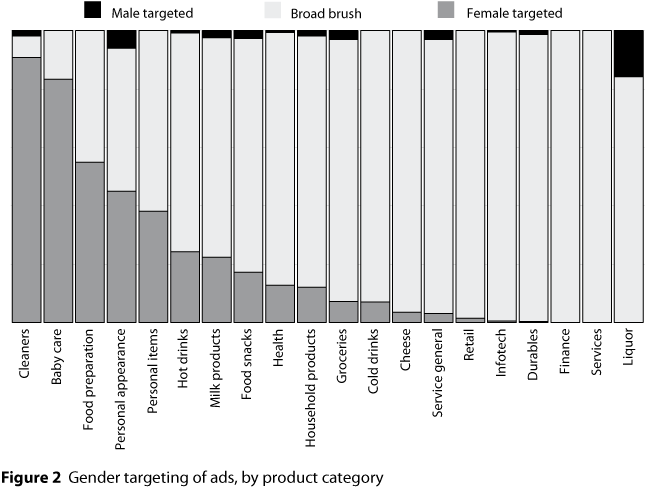
A breakdown of the figures in Table 1 by product category is summarised in Figure 2. This provides some insight into the extent to which what is being advertised determines the gender of those to whom it is being advertised.
From Table 1 and Figure 2, it emerges that, for most products and brands, advertisers rarely direct advertising to a particular gender and that most advertising is broad-brush. Thus, if the audience with whom each ad was tested is any guide, then most advertising for almost anything (except baby care, cleaners and food preparation) is directed to both genders.
Differences in response between males and females
If, as discussed, pre-natal effects do cause gender response differences, then we may logically expect to find that they are inherent in all societies and countries.
Figure 3 shows the difference in average response between males and females in their reaction to the creative ideas in all the 2,542 broad-brush ads. Both males and females were exposed to each of these ads, so the chart reflects real differences in response to the same stimuli. The base number of ads is contained in brackets for each country. Although the number of sample ads may seem comparatively small for some countries, it should be noted that this number refers to the number of different stimuli (ads) presented. Thus, the actual means are based on far larger numbers of individuals’ responses. In addition, it should be noted that the tendency for females to rate more highly is consistent, irrespective of country or sample size.
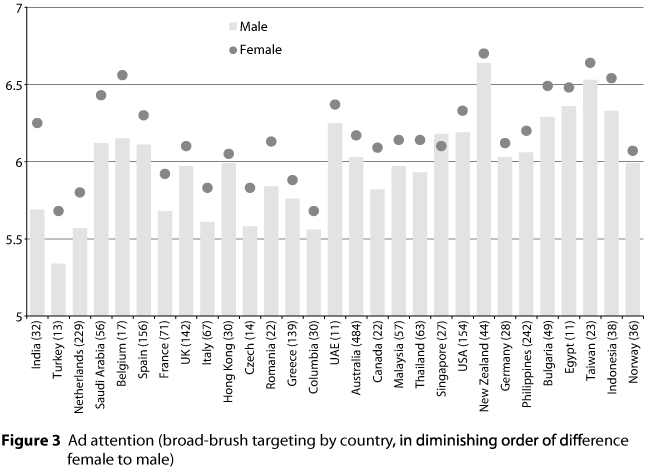
From Figure 3, it is quite apparent that females respond more positively to the creative in the same ads than men do. This consistency seems systemic and the relatively minor variations may be ascribable to subsequent social factors. This may account for the exception of Singapore, where men are more attentive to advertising than are women. However, even here, the advertising has more brand impact on females.
Geographically, the results are widely distributed without apparent regional or cultural clusters.
While Figure 3 demonstrates the difference in how men and women respond to the advertising creative executions, Figure 4 shows the difference in the viewers’ brand attachments after exposure to the advertising. (For ease of visual comparison, Figure 4 is shown in the same country order as Figure 3.)
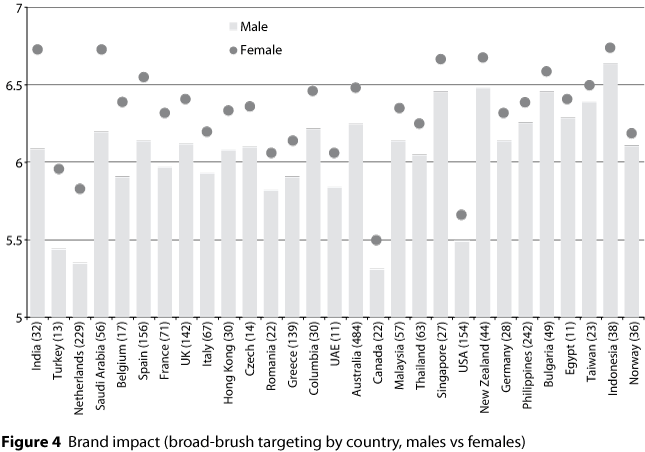
Figure 4 displays the consistent differences between how strongly women and men feel towards the advertised brands after exposure. These differences are generally more pronounced for brand impact than for advertising attention, reflecting a systemically greater emotive feeling towards brands by women. This accords with the overall patterns discussed earlier.
If the differences were gender intrinsic from birth, then any such differences should be consistent across all nations and cultures. As the chart shows, they are. Ockam argued for the simplest explanation. This is provided by accepting the pre-natal effects discussed earlier: that these results are further evidence of an intrinsic gender difference, and that women generally respond more positively to their environment. This is simply manifested in these results relating to advertising creativity and engagement with brands.
Advertising style
If men and women are intrinsically different, then we might expect them to respond differently to different styles of advertising. This can be tested: the overall style of each ad was classified at the time of testing (see Appendix 1). Figures 5 (Ad Attention) and 6 (Brand Impact) show the overall difference in response by Style where both males and females were exposed to the same ad. Males’ average ratings display as vertical light grey bars while a dark grey ball represents the generally more positive female rating. The styles in both charts are arranged in order of diminishing difference between the male and female Attention averages in order to highlight which styles are most effective in both relative and absolute terms.
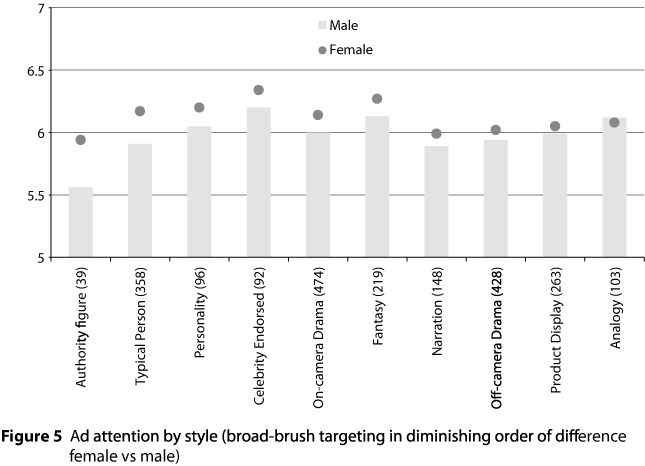
The scale of differences does vary in a predictable way in the light of the earlier discussion. The types of ad where females are much more positive than males are Authority Figure, Typical Person, Demonstration, Personality and Celebrity – that is, ads with people. Figure 5 reinforces the expectation of a more positive response to people by females.
Although still more positive than males, the styles with the fewest gender differences are Product Display, Off-camera Drama and Narration, where people have minimal presence. Analogy is slightly higher for males, suggesting that analogy is a style that men are more likely to accept (as found in other studies of male–female differences cited earlier).
Overall, the most effective attention-getters for females are ads that use Celebrities, Fantasy, Typical Person and Personalities (people). For males, the most effective styles are Analogy, Celebrities and Fantasy.
Figure 6 shows that, irrespective of advertising employed, females feel more positive to the brand after exposure to all styles of advertising, and that what is most effective in terms of getting Attention corresponds with Brand Impact.
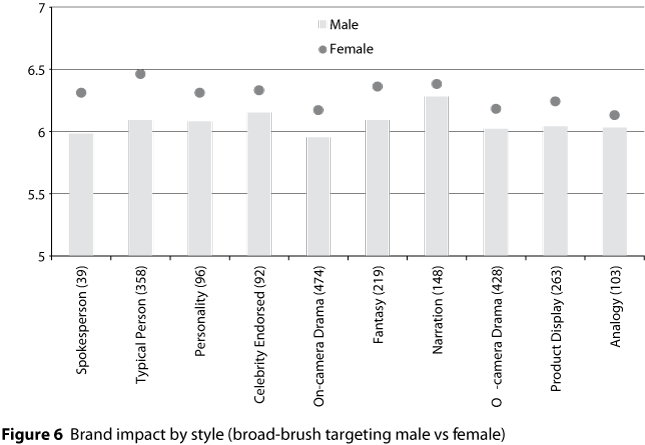
Ad content
In the same way as for Style, depending on the main content of the ad, gender differences might also be expected. This too can be considered: the primary content of each ad is also classified at the time of testing. How relatively effective are ads that employ comparisons, humour, music, etc. as the main theme?
Figures 7 and 8 show the results broken down by the overall content of the ad.
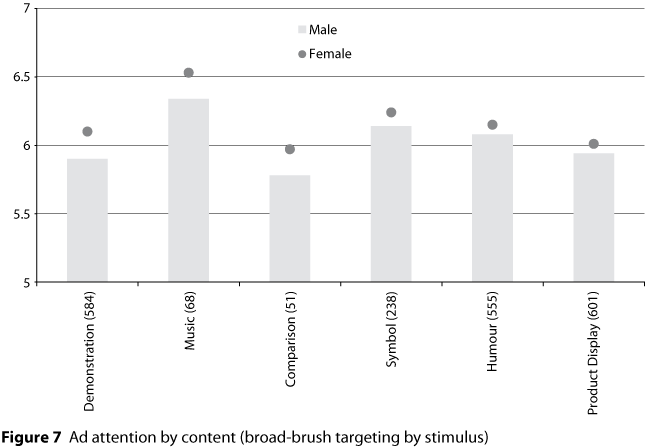
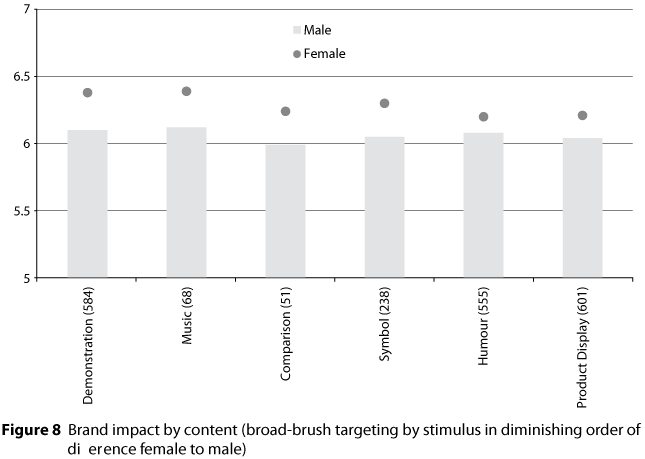
In what is becoming a familiar picture, females respond more positively in all situations (especially music), both to the creative and in terms of consequent brand feelings. Exemplifying the Gear model, the contribution of music is quite clear in terms of gaining ad attention for both genders.
Ads employing comparisons, while of relatively low interest, are very persuasive once viewed. Since such ads need to be viewed less frequently in order to get the message across, low interest may not be a problem.
Broad-brush vs gender targeting
If the objective is to maximise the advertising effect for a particular gender, then it ought to be the case that advertising tailored to a single gender will be more effective. This proves to be the case.
Females by category
Figures 9 and 10 for females compare the typical outcomes with gender-specific vs broad-brush targeting by product category. The categories have been limited to where there are sufficient cases to provide meaningful results. Respective ad numbers are shown in brackets.
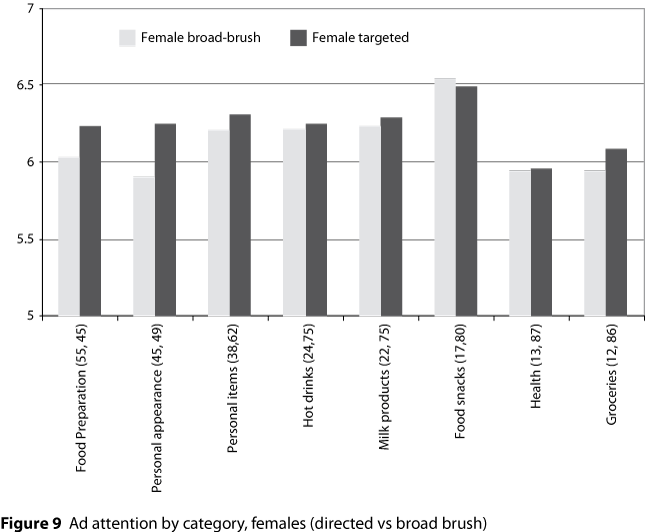
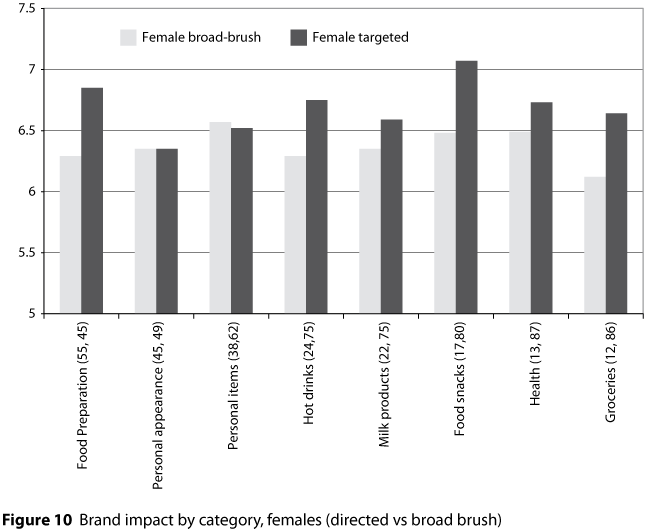
Figure 9 indicates that, with the exception of Food Snacks, women give more attention to ads directed to women. Figure 10 shows that, with the exception of personal appearance, women are more positive to the advertised brands that are targeted directly to them.
Females by style
As was the case when comparing female response by category, Figures 11 and 12 show that when the comparison is made between direct and broad-brush advertising, it does not matter which style is employed, the female-directed advertising is almost without exception more effective. The one exception was for advertising using a authority figure, which received low ratings whether gender-specific or broad-brush.
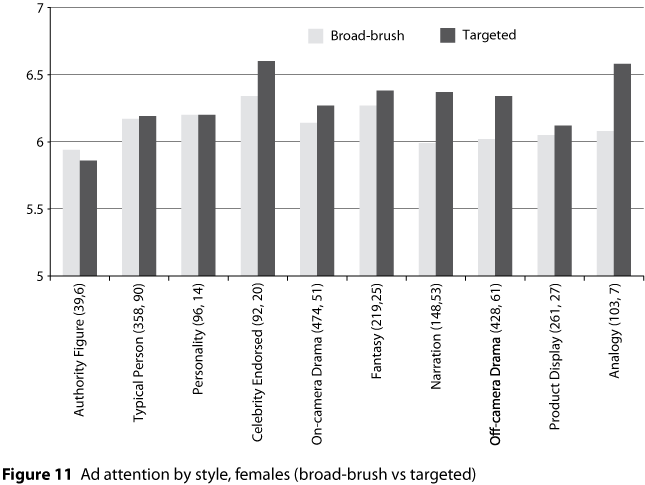
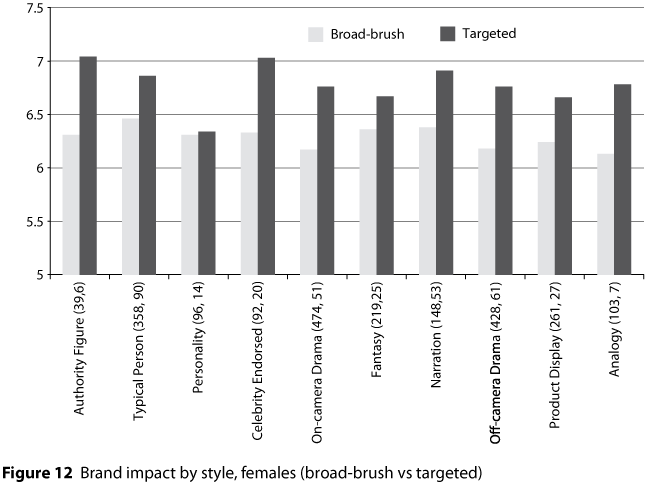
In terms of effective brand outcomes, female-directed advertising employing celebrities and authority figures leaves an exceptionally strong brand feeling. So, once more, ads that include people result in more positive responses from females.
This is even more likely to occur with ads that are specifically tailored to females.
Males by style
Although the pool of data for targeted male advertising is small and the number of ads in each style is relatively small, the corresponding analysis for males is shown in Figures 13 and 14 for completeness, and to show that the results are completely consistent. Males respond better when specifically targeted.
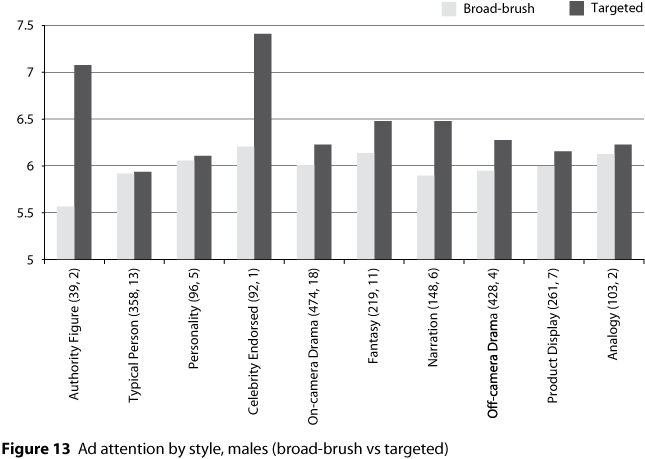
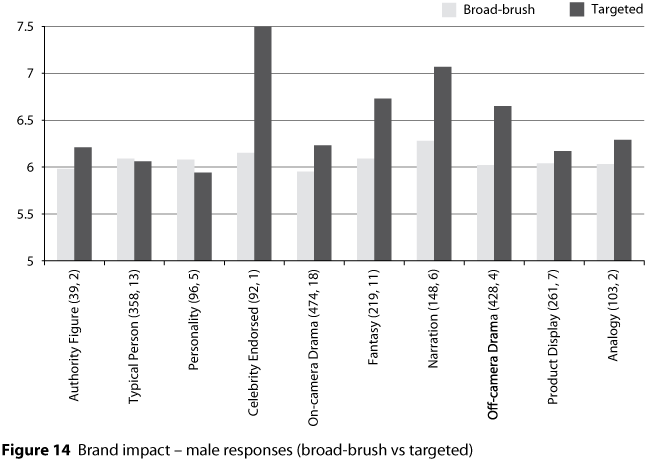
The charts consistently show that gender-directed advertising is more effective for advertising styles for males. If these outcomes were random (like tossing a coin), the probability of getting 10 out of 10 results where ‘targeted’ is better than ‘broad-brush’ is p = 0.001. This outcome is not a quirk of sampling!
In Figure 14, obtaining 8 out of 10 higher targeted outcomes for brand feelings is also significant (p = 0.043), and reinforces a conclusion that single-gender targeted advertising is more effective.
Selection of ad styles
The study has shown that some styles of advertising are more effective than others. Figure 15 shows the relative frequency of use of different ad styles for 2,220 broad-brush ads. Since they are the ads that clients selected for testing, they can be deemed a reasonable cross-section of advertising practice across the world.
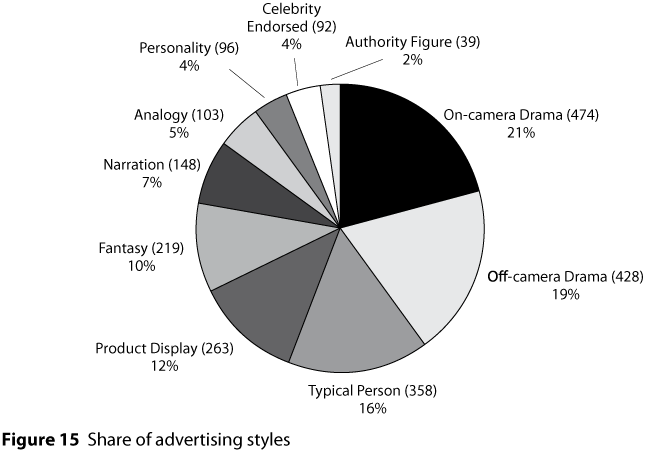
It is thus rather surprising to find that, of the 11 styles listed, just four (On- and Off-camera Drama, Typical Person and Product Display) account for over two-thirds of all advertising tested (and hence, presumably, of all ads).
Figures 16 and 17 reveal an interesting paradox. Frequency of use does not correlate with effectiveness of advertising style: advertisers under-utilise some of the most effective styles.
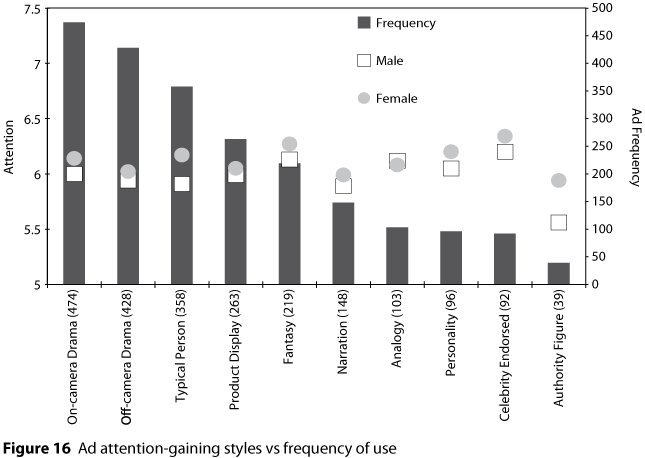
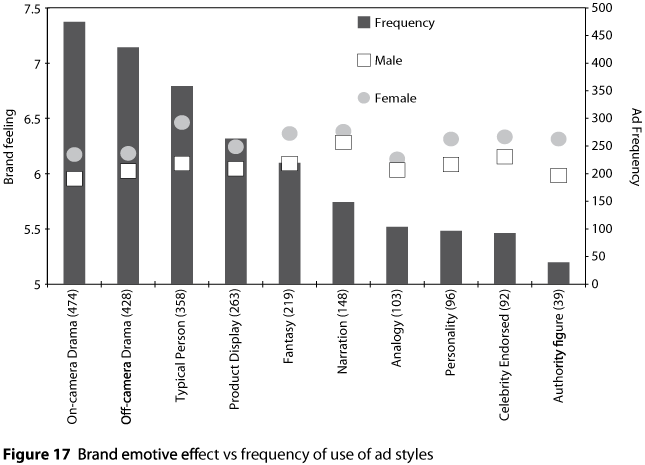
When the frequency of use of individual ad styles is contrasted with the actual effectiveness of the advertising in gaining audience attention, some styles dominate, while others that are at least as effective are seldom employed. For example, Celebrities, Personalities and Analogy are powerful as attention getters (Figures 5 and 6), yet are seldom employed.
Selection of ad main content
Another way to look at the results is to look at the frequency with which ads with a particular content emphasis are used, and compare that frequency with the relative efficiency of the advertising in terms of creative impact and eventual brand feeling.
Figures 18 and 19 show some interesting anomalies. In essence, they show that almost all advertising historically falls into just three styles: product display, demonstration and use of humour. As noted, humour is an efficient adjunct of effective advertising, but to a similar extent, so is music (see Figures 7 and 8). Curiously, as Figure 18 shows, advertisers seldom use either music or comparison-based ads.
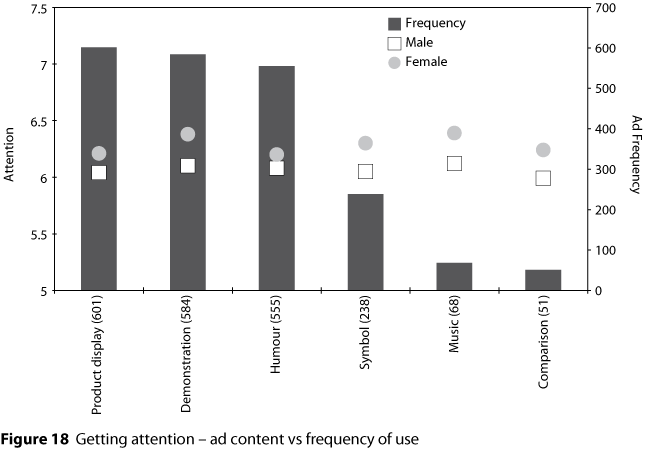
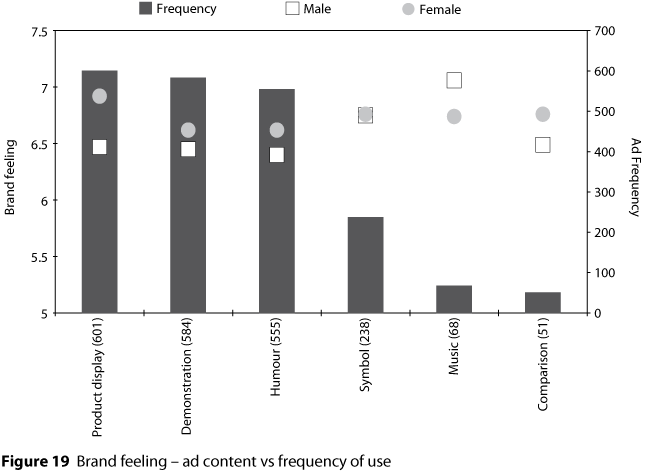
Key findings
General
- By far the majority of advertising tested is directed broad-brush to males and females. However, this is a questionable practice since ads targeted specifically either to males or females are likely to be more effective than those targeted to both.
- Whatever style of advertising is employed, females are likely to respond more positively to it. Confirming the hard-wired gender predisposition findings, gender differences are not due to cultural effects, and different countries experience broadly similar outcomes.
- Ads containing music are consistently effective, yet are seldom utilised.
- Advertisers employ a very limited range of advertising styles. In developing their advertising, they could employ a much wider range and introduce alternative content that would be at least as effective, and often more effective.
- Humour, which is widely used because of its ability to gain awareness, emerges as a double-edged sword. It does not necessarily enhance Brand Impact. Perhaps some humour may result in adverse rub-off on the brand.
- The most effective styles of advertising to females are ads employing Fantasy, a Typical Person and Personalities.
- The introductory discussion identified that females are more socially orientated. It is thus not surprising to find that females respond more positively than males to advertising with people in it (Personality, Celebrity, Typical Person). However, these formats are comparatively under-utilised.
- The most effective ad styles for males are Analogy (a sort of abstraction), Celebrity and Fantasy.
- The use of music leaves males very strongly branded to the advertised brand, but it is seldom employed.
Implications
A slightly higher benchmark may be appropriate for evaluating female responses to advertising, especially in countries where the disparity is large.
Unless advertising production costs are prohibitive, there is a strong case to be made that ads should specifically target females or males when they are the primary intended audience.
It is often asked whether the use of celebrities can be justified. These results support the use of celebrities for advertising, especially when directed to females, as it results in both high attention and high brand impact.
Different styles of advertising work best for women and men. Given the degree of overlap, one may conclude that men do not respond more negatively per se, but rather that men respond positively when the appropriate stimulus is presented. However, assuming what has been tested broadly represents the types and styles of advertising used, then these typical advertising approaches are less well suited to males in almost any category or style of advertising.
Application of these findings should lead to a fine-tuning of the advertising approach rather than a total revolution. The best approach to advertising any product can be determined by examining what works best on a category-by-category basis. Often, current practice is sub-optimal.
It is hard to avoid the conclusion that advertisers are missing some creative opportunities and are somewhat formulaic. As advertisers seek to preserve their traditional offline forms of communication, they will need to raise their game. These results show them a direction in which to go.
Clearly, these are preliminary conclusions and should act as a stimulus to further investigation. However, here are some things to think about …
Five golden rules
- Intrigue males with symbols and abstraction.
- Involve females with empathetic people-populated situations.
- Beware of making too light of what you are saying lest you belittle your subject matter.
- Relevant celebrities and personalities can pay dividends.
- Make music when you advertise!
Appendix 1: Definition of ad styles
Typical Person A non-celebrity delivers the product benefits by endorsing the brand
Celebrity Endorsed A famous celebrity delivers the product benefits by endorsing the brand
Authority Figure A celebrity presents the sales message in an announcement format, but no testimonial is provided
Personality An individual who is the focus of the ad is engaged in some activity but is not providing a testimonial or verbally endorsing the product
Off-camera Drama A drama portraying life or character by means of dialogue or action is performed in the commercial, but the sales message is delivered by an announcer not involved in the drama (usually unseen by the audience)
On-camera Drama Primary sales messages are delivered by the performers engaged in the drama
Narration The story is depicted in the video while an off-camera announcer discusses the advertised product and relates what is happening on-camera. The distinguishing feature between narration and drama is that a story is told, not dramatised
Demonstration The dominant aspect of the commercial is the demonstration of product features
Product Display Product is displayed or shown in use, but no specific product features are demonstrated
Fantasy Ads employing imaginative or unnatural plots and characterisations, e.g. talking animals or cartoon characters
Analogy The product is compared, by analogy, to an unrelated item (such as an animal or a jewel) and the analogy is the focus of the commercial
Mood/Collage The ad is made up of a collage of unrelated images and scenes. Voice-over is given by an off-camera announcer.
http://www.warc.com/Content/ContentViewer.aspx?ID=0e31ff17-9d87-4275-a8b3-fe067bc02180&ID=0e31ff17-9d87-4275-a8b3-fe067bc02180&MasterContentRef=0e31ff17-9d87-4275-a8b3-fe067bc02180
Bandung dan Jakarta, Lokasi Baru Trending Topics
Bandung dan Jakarta, Lokasi Baru Trending Topics
Selasa, 12 April 2011 | 18:40 WIB
TEMPO Interaktif, Situs mikroblogging Twitter melakukan ekspansi pelayanannya. Pada hari ini, Selasa 12 April 2011, Twitter menambah 70 lokasi trending topics, yang terdiri dari negara dan kota. Di antara 70 lokasi itu ada Jakarta dan Bandung.
Dalam pernyataan resminya, Twitter menyatakan dengan tambahan ini maka sekarang ada lebih dari 100 lokasi trending topics.
Sebanyak 70 lokasi baru ini di antaranya, Argentina, Australia, Chile, Kolombia, Prancis, Jerman, India. Sedangkan kota yang baru, Detroit, Miami, Rio De Janiero, Sydney dan Toronto.
Dengan tambahan lokasi ini, para pemilik akun Twitter bisa melihat topik yang paling panas dan populer yang sedang dibicarakan di lokasi tersebut. Lokasi-lokasi baru itu tercantum di dalam daftar negara.
Misalnya, Jakarta dan Bandung ada di dalam Indonesia. Bila para pemilik akun ingin melihat trending topic di Bandung atau Jakarta, mereka harus mengganti lokasi sebelumnya.
Pada 21 Maret lalu, Twitter merayakan ulang tahun ke-5. Meski muda, twitter yang dicetuskan Jack Dorsey pada 21 Maret 2006 sungguh mengubah kehidupan manusia. Revolusi Timur Tengan dan Afrika adalah salah satu bukti kedahsyatan jejaring sosial ini.
Berawal dari sebuah kicauan (tweet) "Inviting coworkers" atau mengundang rekan kerja, lima tahun lalu, pengguna twitter terus bertambah. Kini sedikitnya ada 50 juta tweet setiap hari setara dengan 600 tweet tiap detik.
Indonesia pun tercatat sebagai salah satu pengguna twitter terbanyak di dunia. Juni 2010, pengguna twitter Indonesia mencapai 6,2 juta akun.
http://www.tempointeraktif.com/hg/it/2011/04/12/brk,20110412-326993,id.html
Facebook to Ad Agencies: Let's Be 'in a Relationship'
Facebook to Ad Agencies: Let's Be 'in a Relationship'
Social Network Rolls Out Community Site Aimed at Creatives
By: Irina Slutsky Bio
Published: April 18, 2011 Facebook today launched a stand-alone community site (facebook-studio.com) where ad agency creatives can share ideas, comment on campaigns and learn what it takes to create a successful page for a brand. The community is called "Facebook Studio" and is a platform aimed at agencies, PR firms and media strategy companies.
 Facebook executives say this move is a first step in a give-and-take dialogue between Facebook and the creative advertising world. Until now, Facebook has been mostly hands-off with agencies, letting them navigate the frequently changing Facebook waters without a compass.
Facebook executives say this move is a first step in a give-and-take dialogue between Facebook and the creative advertising world. Until now, Facebook has been mostly hands-off with agencies, letting them navigate the frequently changing Facebook waters without a compass.
"We need to do a better job of engaging with agencies," said Blake Chandlee, head of Facebook's newly formed agency relations team, adding that the site will focus on best practices and highlight quality campaigns uploaded by the creators of the content. Of course, users will be commenting and clicking that like button, so the most talked-about work will get the most attention. Facebook wants the people with the advertising smarts to take the lead. "So far we've felt like they've been pulled along," Mr. Chandlee said.
A team was hired in August to facilitate agency relations and met with shops for the past six months to learn what they needed. Along with the website, Facebook is holding events called Studio Live -- hackathon-style problem solving and "best in show" sessions. A Toronto event took place earlier this year with Publicis, Interpublic, Omnicom, WPP and Havas in attendance.
Agencies are interested to see what happens, and ultimately want more. "Beyond the studio, which is a great first step, we're looking to Facebook to open the kimono more in areas like product development to bring smarter, more integrated programs to our clients," said Sarah Hofstetter, senior VP at 360i, who has worked with Coca-Cola, Kraft Foods and Bravo.
"The tools and products Facebook develops, which spread information about their platform, will not only help it seem less daunting, but encourage brands to further utilize the platform as well as experiment with it," said Jasmine Summerset, strategy supervisor at Pereira & O'Dell. The next Facebook Studio Live event is planned for May 12 in New York.
http://adage.com/article/digital/facebook-ad-agencies-a-relationship/227051/

Facebook Studio
"We need to do a better job of engaging with agencies," said Blake Chandlee, head of Facebook's newly formed agency relations team, adding that the site will focus on best practices and highlight quality campaigns uploaded by the creators of the content. Of course, users will be commenting and clicking that like button, so the most talked-about work will get the most attention. Facebook wants the people with the advertising smarts to take the lead. "So far we've felt like they've been pulled along," Mr. Chandlee said.
A team was hired in August to facilitate agency relations and met with shops for the past six months to learn what they needed. Along with the website, Facebook is holding events called Studio Live -- hackathon-style problem solving and "best in show" sessions. A Toronto event took place earlier this year with Publicis, Interpublic, Omnicom, WPP and Havas in attendance.
Agencies are interested to see what happens, and ultimately want more. "Beyond the studio, which is a great first step, we're looking to Facebook to open the kimono more in areas like product development to bring smarter, more integrated programs to our clients," said Sarah Hofstetter, senior VP at 360i, who has worked with Coca-Cola, Kraft Foods and Bravo.
"The tools and products Facebook develops, which spread information about their platform, will not only help it seem less daunting, but encourage brands to further utilize the platform as well as experiment with it," said Jasmine Summerset, strategy supervisor at Pereira & O'Dell. The next Facebook Studio Live event is planned for May 12 in New York.
http://adage.com/article/digital/facebook-ad-agencies-a-relationship/227051/
Monday, April 18, 2011
Sembilan Barang yang Tergilas Ponsel
Sembilan Barang yang Tergilas Ponsel
SENIN, 18 APRIL 2011 | 10:16 WIB
TEMPO Interaktif, Jakarta - Telepon selular sepertinya kini menjadi barang "wajib" yang melekat pada diri kita setiap hari. Tapi sadarkah Anda, perangkat mobile ini telah mengambil alih fungsi berbagai barang yang dulu sering digunakan.
Apa saja barang yang tegilas kecanggihan ponsel? Mengutip situs teknologi PC World, berikut adalah daftar sembilan barang-barang yang menjadi daftar "korban" keberadaan ponsel.
1. MP3 Player
Kapan terakhir kali Anda membawa pemutar musik digital ini? Ketika Apple memperkenalkan iPhone pada tahun 2007, era MP3 Player mulai meredup. Kendati Apple juga memproduksi iPod yang juga bisa digunakan sebagai alat pemutar musik, namun penjualannya mulai menurun selama beberapa waktu.
2. Portable Game Consol
Konsol game mulai ditinggalkan ketika orang dapat nge-game di ponsel. Apalagi Sony baru-baru ini meluncurkan ponsel khusus game dengan nama Sony Ericsson Xperia Play dan ada ribuan game yang tersedia di Android Market dan iTunes App Store. Tapi setidaknya, masih ada para pecinta game yang tetap setiap pada portable game consol.
3. Kamera
Tak perlu lagi menenteng kamera untuk mengabadikan gambar. Kini berbagai ponsel sudah dilengkapi fitur kamera dengan resolusi yang tak kalah dibanding kamera saku.
4. Video Player
Soal kemampuan memutar video, saat ini vendor posel sudah berlomba-lomba menghadirkan telepon yang dapat memutar video dengan mulus, layar yang lebih cerah dan tajam. Ada pula ponsel yang memiliki layanan untuk merekam video dan langsung dapat diunggah ke Internet.
5. Alat perekam suara
Selain dapat digunakan untuk berkomunikasi, ponsel juga dilengkapi fitur perekam suara. Meskipun kapasitas suara yang direkam tergantung pada jenis ponselnya, namun layanan ini diperkirakan mampu menggerus pasar alat perekam.
6. Perangkat navigasi GPS
Mengapa harus membeli perangkat GPS terpisah untuk dipasang pada mobil jika ponsel Anda dapat melakukan tugas yang sama? Berbagai perusahaan, seperti Garmin, Magellan, dan TomTom selama ini telah menyediakan perangkat navigasi GPS. Sekarang mereka harus beralih dengan cara menawarkan aplikasi seperti Garmin StreetPilot, yang memberikan arah untuk pengguna smartphone.
7. Personal Digital Assistant (PDA)
PDA adalah perangkat cerdas yang mulai populer pada 2001. Saat itu, PDA dikenal sebagai Pocket PC karena di situ, Anda bisa menulis berbagai catatan, menyimpan ribuan nomor telepon, dan sebagainya. Tapi sekarang PDA mulai meredup karena ponsel dapat menggantikan seluruh fungsi yang ada di sana.
8. Jam tangan
Tak perlu menengok pergelangan tangan Anda untuk mengetahui jam berapa sekarang. Di ponsel, fungsi jam sudah diatur secara otomatis sesuai dengan kinerjanya. Pengguna juga tak perlu repot mengganti baterai seperti pada jam tangan karena baterainya dapat diisi ulang.
9. Gulungan peta
Apakah Anda masih menggunakan peta yang terpampang di atas kertas? Sekarang melalui ponsel Anda bisa menjelajahi wilayah mana saja karena layarnya akan menunjukkan daerah yang Anda maksud. Berbagai aplikasi peta juga sudah tersedia dan dapat diakses secara gratis, seperti Google Map, MapQuest, dan Bing.
PC World|Rini K
http://tempointeraktif.com/hg/it/2011/04/18/brk,20110418-328238,id.html
SENIN, 18 APRIL 2011 | 10:16 WIB
TEMPO Interaktif, Jakarta - Telepon selular sepertinya kini menjadi barang "wajib" yang melekat pada diri kita setiap hari. Tapi sadarkah Anda, perangkat mobile ini telah mengambil alih fungsi berbagai barang yang dulu sering digunakan.
Apa saja barang yang tegilas kecanggihan ponsel? Mengutip situs teknologi PC World, berikut adalah daftar sembilan barang-barang yang menjadi daftar "korban" keberadaan ponsel.
1. MP3 Player
Kapan terakhir kali Anda membawa pemutar musik digital ini? Ketika Apple memperkenalkan iPhone pada tahun 2007, era MP3 Player mulai meredup. Kendati Apple juga memproduksi iPod yang juga bisa digunakan sebagai alat pemutar musik, namun penjualannya mulai menurun selama beberapa waktu.
2. Portable Game Consol
Konsol game mulai ditinggalkan ketika orang dapat nge-game di ponsel. Apalagi Sony baru-baru ini meluncurkan ponsel khusus game dengan nama Sony Ericsson Xperia Play dan ada ribuan game yang tersedia di Android Market dan iTunes App Store. Tapi setidaknya, masih ada para pecinta game yang tetap setiap pada portable game consol.
3. Kamera
Tak perlu lagi menenteng kamera untuk mengabadikan gambar. Kini berbagai ponsel sudah dilengkapi fitur kamera dengan resolusi yang tak kalah dibanding kamera saku.
4. Video Player
Soal kemampuan memutar video, saat ini vendor posel sudah berlomba-lomba menghadirkan telepon yang dapat memutar video dengan mulus, layar yang lebih cerah dan tajam. Ada pula ponsel yang memiliki layanan untuk merekam video dan langsung dapat diunggah ke Internet.
5. Alat perekam suara
Selain dapat digunakan untuk berkomunikasi, ponsel juga dilengkapi fitur perekam suara. Meskipun kapasitas suara yang direkam tergantung pada jenis ponselnya, namun layanan ini diperkirakan mampu menggerus pasar alat perekam.
6. Perangkat navigasi GPS
Mengapa harus membeli perangkat GPS terpisah untuk dipasang pada mobil jika ponsel Anda dapat melakukan tugas yang sama? Berbagai perusahaan, seperti Garmin, Magellan, dan TomTom selama ini telah menyediakan perangkat navigasi GPS. Sekarang mereka harus beralih dengan cara menawarkan aplikasi seperti Garmin StreetPilot, yang memberikan arah untuk pengguna smartphone.
7. Personal Digital Assistant (PDA)
PDA adalah perangkat cerdas yang mulai populer pada 2001. Saat itu, PDA dikenal sebagai Pocket PC karena di situ, Anda bisa menulis berbagai catatan, menyimpan ribuan nomor telepon, dan sebagainya. Tapi sekarang PDA mulai meredup karena ponsel dapat menggantikan seluruh fungsi yang ada di sana.
8. Jam tangan
Tak perlu menengok pergelangan tangan Anda untuk mengetahui jam berapa sekarang. Di ponsel, fungsi jam sudah diatur secara otomatis sesuai dengan kinerjanya. Pengguna juga tak perlu repot mengganti baterai seperti pada jam tangan karena baterainya dapat diisi ulang.
9. Gulungan peta
Apakah Anda masih menggunakan peta yang terpampang di atas kertas? Sekarang melalui ponsel Anda bisa menjelajahi wilayah mana saja karena layarnya akan menunjukkan daerah yang Anda maksud. Berbagai aplikasi peta juga sudah tersedia dan dapat diakses secara gratis, seperti Google Map, MapQuest, dan Bing.
PC World|Rini K
http://tempointeraktif.com/hg/it/2011/04/18/brk,20110418-328238,id.html
Web Research is About More Than Social Media
Web Research is About More Than Social Media
by Tracy Panko on April 11, 2011
JP Morgan Chase recently conducted a test using a $5 ATM fee in Illinois.
At first glance, when I read about this—and found that shortly thereafter the market test was stopped—I assumed this meant that no one would accept such a fee and overall, the concept was a failure. But that conclusion would have been presumptuous at best, based on limited data and the narrow scope of my consideration.
Instead, using the Spiral16 web measurement platform, we conducted a short research project (5 days worth of data) focused solely on the terms “Chase,” “Bank,” “ATM,” and “fee” or “fees.” The results were eye-opening and educational.
Social Media Doesn’t Tell the Whole Story
Most of the sentiment on Twitter was negative. Users mostly agreed that the fee was unwarranted and showed that customers would leave. Some examples:
• From @joshuanovy: Chase bank tests out $5 ATM fees in IL and TX for non-Chase customers. I’ll be testing out beating the hell out of any ATM charging me $5.
• From @theworkroomNYC: Seriously, Chase Bank…$5 ATM fees for non Chase customers. I am a customer and you are making me rethink it.
However, if you expand your view and look at all of the sources of information available on the Internet, you would see that overall sentiment was not completely negative.
Many of the news sources have concluded that this is a push back against financial reforms. Brian Foran, a banking analyst at Nomura Securities International in New York, says the rising fees are part of an effort by the banks to recoup some of the income they lost from two recent regulatory changes. “J.P. Morgan has a secondary motivation of trying to send a pretty clear message to Washington that if you regulate prices, we have to charge more somewhere else,” Foran says.
Even if as a consumer, I would not pay a $5 ATM fee – I am interested in learning more about the financial regulation that is supposed to “help” the American consumer, but instead puts the burden on us to replace lost revenue from the Durbin Amendment.
Online Data From All Over the Web is Valuable
Market tests continue to be an effective way of getting a quick evaluation on a change to your products and services. The great news for business decision-makers is this:
The Web provides a tremendous opportunity to supplement the results of the market test with unsolicited data from current customers, prospective customers, market analysts, news sources, industry experts, and more.
In just a few short days, over 700 web pages discussed Chase Bank $5 ATM Fee. The sources of that data expanded well beyond Twitter and other social sources.
According to CNBC.com, JP Morgan Chase ended its controversial test of higher ATM fees targeted at non-bank customers on Friday April 1, citing sources at the bank that say they have no plans at present to permanently increase ATM fees and no further tests are being planned.
For all of us conducting research; whether that’s Internet research, market tests, focus groups, or structured surveys, we need to remember to keep our minds open to drawing conclusions based on the details found in the data. Don’t be overwhelmed with the “data deluge.”
(Gartner predicted that enterprise data in all forms will grow 650% over the next five years.)
It’s important that the data that’s relevant to you rises to the top, and equally important to remember to take the bigger online picture into consideration, not just social media.
http://www.spiral16.com/blog/2011/04/web-research-is-about-more-than-social-media/
Friday, April 15, 2011
Global Brands, Indonesia Flair
Global Brands, Indonesia Flair
Sylviana Hamdani | April 15, 2011
It’s hard to imagine Jakarta without Starbucks, LG and McDonald’s. But there was a time, not so long ago, when none of them had any footing in this country.
The first McDonald’s in Indonesia opened in Jakarta’s Sarinah building in 1991. While initially wildly popular, the Sarinah outlet has seen many ups and downs over the years, including a recent temporary closure. But since it reopened on Feb. 14, the fast-food outlet has been more popular than ever, with the premises often completely packed late into the night.
“It’s always full on the weekend,” said Sukana Jaya, a graphic designer who was meeting up with friends at the restaurant. “But we still want to come here.”
Sukana said a big part of the venue’s attraction was its new decor.
“It’s great. I really love it,” he said. “From the outside, it doesn’t look any different from all the other buildings in this area. But, on the inside, it’s so warm and cozy.”
That feeling of warmth and familiarity is no accident. When the McDonald’s outlet reopened on Valentine’s Day, customers were introduced to a whole new design, one that incorporates elements of Indonesian culture and art.
The two-story restaurant and cafe now features parquet flooring, dark wood panels and elegant glass partitions. The partitions feature an ancient geometric batik pattern, known as kawung . A glass panel on the wall leading to the cashier counter is decked out in Jawa Hokokai batik from Pekalongan, Central Java. Its vibrantly colored motif of butterflies floating over a flower garden brightens the warm and elegant decor.
“We incorporate Indonesian cultural elements into our restaurants’ decor and architectural designs as a show of our appreciation for the local culture,” said Michael Hartono, communications and marketing director of Rekso Nasional Food, the licensee of McDonald’s in Indonesia.
While many people think of McDonald’s as a prime example of American culture invading the rest of the world, part of the reason for the company’s international success is its ability to adapt to the tastes and cultures of different countries. It’s a lesson that applies far beyond fast food.
“There’s no such thing as a real ‘global’ product nowadays,” said Hermawan Kartajaya, a marketing expert and CEO of MarkPlus Consulting, a company that advises international companies looking to do business in Indonesia. “To survive in local markets, all international products have to localize in terms of their content or context.”
Hermawan said one example of McDonald’s adaptability to local markets was the Maharaja Mac, which is served in all of its outlets in India. The burger, made with lamb instead of beef, is a necessity in a country filled with Hindus who believe cows are sacred.
“McDonald’s wouldn’t sell many burgers [in India] if they tried to serve beef,” Hermawan said.
McDonald’s made similar alterations to its menu in Indonesia out of respect for local culture and to appeal to familiar tastes. It doesn’t serve pork, which is forbidden in Islam, and two of its most popular items in Indonesia, fried chicken and rice, are not available in America.
“Brands are like people,” said Yuswohady, chief executive of the MarkPlus Institute of Marketing. “They have their own image and characteristics. Each has a unique relationship with its customers.”
“To survive in the Indonesian market, global products need to maintain an emotional connection with their local customers,” he continued. “They need to localize their products and brand’s identities. I call this ‘glocalization.’ ”
McDonald’s has made great efforts to glocalize its famous brand in Indonesia. For example, the facade of the McDonald’s outlet in Boulevard, a tourist area in Manado, North Sulawesi, has been designed to resemble a traditional junk out of respect for the local seafaring culture.
In Kebo Iwa, Denpasar, the outlet includes local architectural design elements, such as a bale bengong (gazebo) and sanggha (small temple) to place offerings to the gods.
But McDonald’s adoption of the local culture goes beyond its restaurants’ facades and interiors.
“Step by step, we’re also substituting all of our imported ingredients with local products,” Michael said.
According to the communications and marketing director, 85 percent of the restaurants’ ingredients, such as rice, eggs, chicken and vegetables, are now sourced locally. It’s a move that helps the company support the local economy as well as cut costs and deliver fresher ingredients.
Another international company going the extra mile to glocalize is South Korean electronics giant LG. The company, which recently celebrated its 20th anniversary of doing business in Indonesia, said part of the reason for its success here was its extensive customer surveys and market research that allowed it to develop products in line with the needs and wants of local customers.
Based on this research, it launched a new line of LG microwave ovens in December that features settings designed to cook specific Indonesian dishes, such as sate ayam (chicken skewers), bolu kukus (a type of cake) and kolak pisang (braised banana in palm sugar sauce).
“Our aim is not merely to satisfy our customers, but to delight them as well,” said Michael Adisuhanto, head of LG’s home appliance division. “That’s why we work so hard to develop new products that truly fit the needs of Indonesians.”
In collaboration with Yayasan Batik Indonesia (Indonesian Batik Foundation), the company has also applied batik designs to its home appliances. In October 2010, 15 batik artisans from across the country were commissioned by LG to paint batik motifs on the surfaces of 10 refrigerators and washing machines.
The products are officially the first home appliances to feature batik motifs, according to the Indonesian Museum of Records (MURI).
“LG is a multinational electronics company,” Michael said. “By applying batik to our home appliances, we show that we also appreciate Indonesian culture.”
Among the 15 batik patterns used on the products were Batik Yogya, Batik Banyumasan (East Java) and Batik Madura.
The washing machines and refrigerators were sold at a private auction in Jakarta in December. Each of the products was sold for approximately two to three times its original price. The proceeds from the auction, totaling Rp 75.5 million ($8,700), were donated to Yayasan Perempuan Untuk Negeri (Women for the Nation Foundation) in Jakarta.
LG is now planning to mass produce the batik-motif washing machines and refrigerators and make them available to the public.
“This is modernization,” said Sri Soedewi Samsi, a batik expert and author of “Teknik dan Ragam Hias Batik Yogya & Solo” (“Techniques and Ornaments of Yogya & Solo Batik”). “Today, we can see batik not only on clothes, but also on home appliances. In my opinion, this is a good way to perpetuate our culture. Culture has to adapt in order to survive in the modern world.”
The famous Starbucks chain of coffeehouses has only been in Indonesia since 2002, when the first outlet opened in Plaza Indonesia. The company, which has more than 17,000 stores in 50 countries, including 92 outlets in Indonesia, has become a global force thanks to its strong brand, but it has also made strong efforts to integrate itself into local communities.
And, like McDonald’s and LG, one of the ways it is doing that here is through the use of batik. The company hired fashion designer Iwet Ramadhan to come up with special uniforms for its baristas using the iconic Indonesian patterns.
“I felt both flattered and challenged,’’ Iwet said. “Starbucks is like the number one coffee shop in the world. I wanted to portray that image in my design.’’
He chose to put Sekar Jagad, the traditional Javanese portrayal of a world map using batik design, onto the black T-shirts worn by Starbucks baristas.
“The motif also signifies the harmonious relationship between Starbucks products and the community,” Iwet said.
The copper-hued motif is featured on a triangular pattern on the shirts’ left sleeve.
‘’At first glance, I didn’t realize it was batik,” said coffee-lover Cynthia Keliat. “But when I finally did, I have to admit, I felt a surge of pride that a big international company like Starbucks would use batik on their uniforms.”
Anthony Cottan, director of food and beverage concepts at Mitra Adi Perkasa, the sole licensee of Starbucks in the country, said they wanted to make sure and put an Indonesian face on the company.
“We want to make sure that Indonesian customers can see that we’re not just some big US company,” he said. “We’re also a company that understands Indonesia.”
http://www.thejakartaglobe.com/lifeandtimes/global-brands-indonesia-flair/435668
Sylviana Hamdani | April 15, 2011
It’s hard to imagine Jakarta without Starbucks, LG and McDonald’s. But there was a time, not so long ago, when none of them had any footing in this country.
The first McDonald’s in Indonesia opened in Jakarta’s Sarinah building in 1991. While initially wildly popular, the Sarinah outlet has seen many ups and downs over the years, including a recent temporary closure. But since it reopened on Feb. 14, the fast-food outlet has been more popular than ever, with the premises often completely packed late into the night.
“It’s always full on the weekend,” said Sukana Jaya, a graphic designer who was meeting up with friends at the restaurant. “But we still want to come here.”
Sukana said a big part of the venue’s attraction was its new decor.
“It’s great. I really love it,” he said. “From the outside, it doesn’t look any different from all the other buildings in this area. But, on the inside, it’s so warm and cozy.”
That feeling of warmth and familiarity is no accident. When the McDonald’s outlet reopened on Valentine’s Day, customers were introduced to a whole new design, one that incorporates elements of Indonesian culture and art.
The two-story restaurant and cafe now features parquet flooring, dark wood panels and elegant glass partitions. The partitions feature an ancient geometric batik pattern, known as kawung . A glass panel on the wall leading to the cashier counter is decked out in Jawa Hokokai batik from Pekalongan, Central Java. Its vibrantly colored motif of butterflies floating over a flower garden brightens the warm and elegant decor.
“We incorporate Indonesian cultural elements into our restaurants’ decor and architectural designs as a show of our appreciation for the local culture,” said Michael Hartono, communications and marketing director of Rekso Nasional Food, the licensee of McDonald’s in Indonesia.
While many people think of McDonald’s as a prime example of American culture invading the rest of the world, part of the reason for the company’s international success is its ability to adapt to the tastes and cultures of different countries. It’s a lesson that applies far beyond fast food.
“There’s no such thing as a real ‘global’ product nowadays,” said Hermawan Kartajaya, a marketing expert and CEO of MarkPlus Consulting, a company that advises international companies looking to do business in Indonesia. “To survive in local markets, all international products have to localize in terms of their content or context.”
Hermawan said one example of McDonald’s adaptability to local markets was the Maharaja Mac, which is served in all of its outlets in India. The burger, made with lamb instead of beef, is a necessity in a country filled with Hindus who believe cows are sacred.
“McDonald’s wouldn’t sell many burgers [in India] if they tried to serve beef,” Hermawan said.
McDonald’s made similar alterations to its menu in Indonesia out of respect for local culture and to appeal to familiar tastes. It doesn’t serve pork, which is forbidden in Islam, and two of its most popular items in Indonesia, fried chicken and rice, are not available in America.
“Brands are like people,” said Yuswohady, chief executive of the MarkPlus Institute of Marketing. “They have their own image and characteristics. Each has a unique relationship with its customers.”
“To survive in the Indonesian market, global products need to maintain an emotional connection with their local customers,” he continued. “They need to localize their products and brand’s identities. I call this ‘glocalization.’ ”
McDonald’s has made great efforts to glocalize its famous brand in Indonesia. For example, the facade of the McDonald’s outlet in Boulevard, a tourist area in Manado, North Sulawesi, has been designed to resemble a traditional junk out of respect for the local seafaring culture.
In Kebo Iwa, Denpasar, the outlet includes local architectural design elements, such as a bale bengong (gazebo) and sanggha (small temple) to place offerings to the gods.
But McDonald’s adoption of the local culture goes beyond its restaurants’ facades and interiors.
“Step by step, we’re also substituting all of our imported ingredients with local products,” Michael said.
According to the communications and marketing director, 85 percent of the restaurants’ ingredients, such as rice, eggs, chicken and vegetables, are now sourced locally. It’s a move that helps the company support the local economy as well as cut costs and deliver fresher ingredients.
Another international company going the extra mile to glocalize is South Korean electronics giant LG. The company, which recently celebrated its 20th anniversary of doing business in Indonesia, said part of the reason for its success here was its extensive customer surveys and market research that allowed it to develop products in line with the needs and wants of local customers.
Based on this research, it launched a new line of LG microwave ovens in December that features settings designed to cook specific Indonesian dishes, such as sate ayam (chicken skewers), bolu kukus (a type of cake) and kolak pisang (braised banana in palm sugar sauce).
“Our aim is not merely to satisfy our customers, but to delight them as well,” said Michael Adisuhanto, head of LG’s home appliance division. “That’s why we work so hard to develop new products that truly fit the needs of Indonesians.”
In collaboration with Yayasan Batik Indonesia (Indonesian Batik Foundation), the company has also applied batik designs to its home appliances. In October 2010, 15 batik artisans from across the country were commissioned by LG to paint batik motifs on the surfaces of 10 refrigerators and washing machines.
The products are officially the first home appliances to feature batik motifs, according to the Indonesian Museum of Records (MURI).
“LG is a multinational electronics company,” Michael said. “By applying batik to our home appliances, we show that we also appreciate Indonesian culture.”
Among the 15 batik patterns used on the products were Batik Yogya, Batik Banyumasan (East Java) and Batik Madura.
The washing machines and refrigerators were sold at a private auction in Jakarta in December. Each of the products was sold for approximately two to three times its original price. The proceeds from the auction, totaling Rp 75.5 million ($8,700), were donated to Yayasan Perempuan Untuk Negeri (Women for the Nation Foundation) in Jakarta.
LG is now planning to mass produce the batik-motif washing machines and refrigerators and make them available to the public.
“This is modernization,” said Sri Soedewi Samsi, a batik expert and author of “Teknik dan Ragam Hias Batik Yogya & Solo” (“Techniques and Ornaments of Yogya & Solo Batik”). “Today, we can see batik not only on clothes, but also on home appliances. In my opinion, this is a good way to perpetuate our culture. Culture has to adapt in order to survive in the modern world.”
The famous Starbucks chain of coffeehouses has only been in Indonesia since 2002, when the first outlet opened in Plaza Indonesia. The company, which has more than 17,000 stores in 50 countries, including 92 outlets in Indonesia, has become a global force thanks to its strong brand, but it has also made strong efforts to integrate itself into local communities.
And, like McDonald’s and LG, one of the ways it is doing that here is through the use of batik. The company hired fashion designer Iwet Ramadhan to come up with special uniforms for its baristas using the iconic Indonesian patterns.
“I felt both flattered and challenged,’’ Iwet said. “Starbucks is like the number one coffee shop in the world. I wanted to portray that image in my design.’’
He chose to put Sekar Jagad, the traditional Javanese portrayal of a world map using batik design, onto the black T-shirts worn by Starbucks baristas.
“The motif also signifies the harmonious relationship between Starbucks products and the community,” Iwet said.
The copper-hued motif is featured on a triangular pattern on the shirts’ left sleeve.
‘’At first glance, I didn’t realize it was batik,” said coffee-lover Cynthia Keliat. “But when I finally did, I have to admit, I felt a surge of pride that a big international company like Starbucks would use batik on their uniforms.”
Anthony Cottan, director of food and beverage concepts at Mitra Adi Perkasa, the sole licensee of Starbucks in the country, said they wanted to make sure and put an Indonesian face on the company.
“We want to make sure that Indonesian customers can see that we’re not just some big US company,” he said. “We’re also a company that understands Indonesia.”
http://www.thejakartaglobe.com/lifeandtimes/global-brands-indonesia-flair/435668
Subscribe to:
Posts (Atom)




